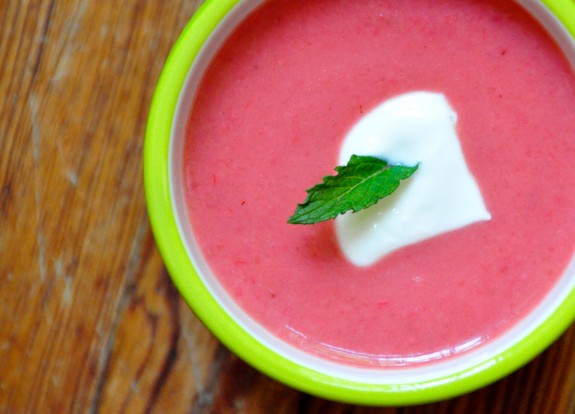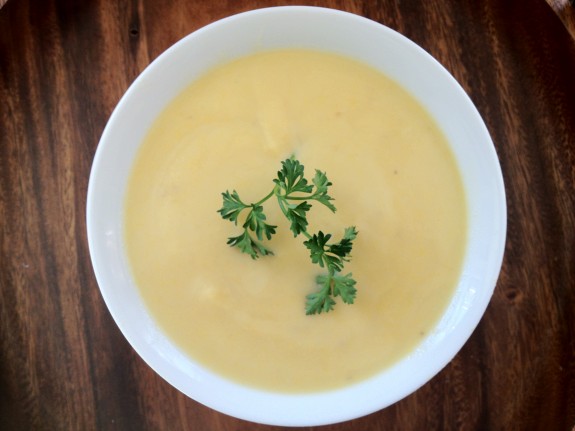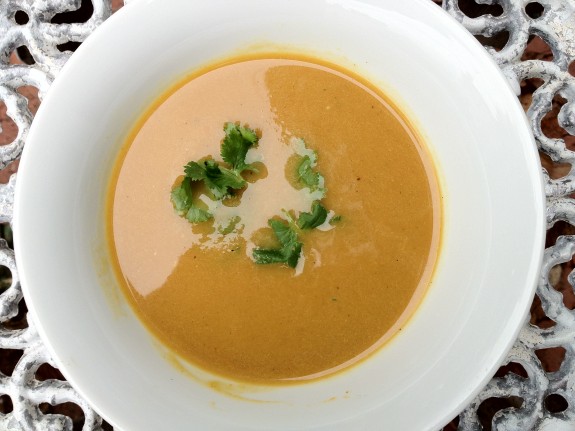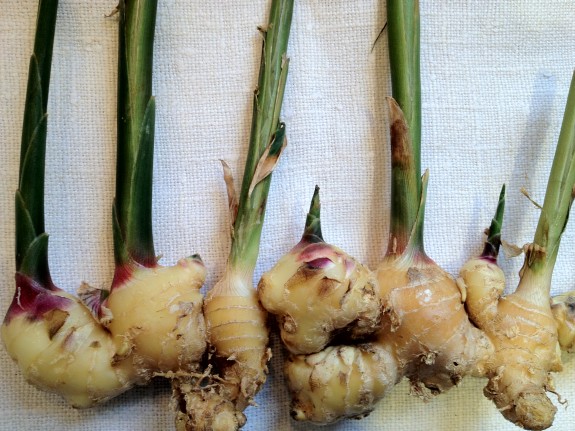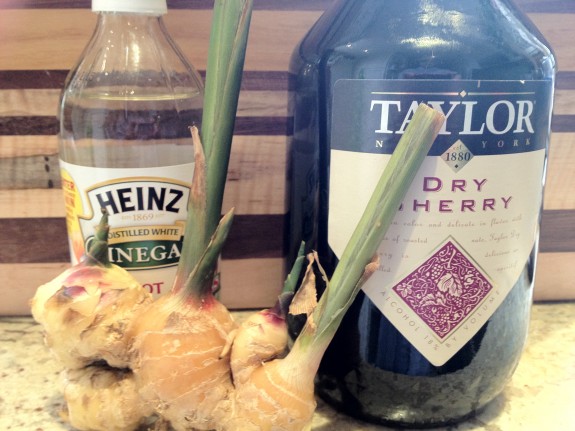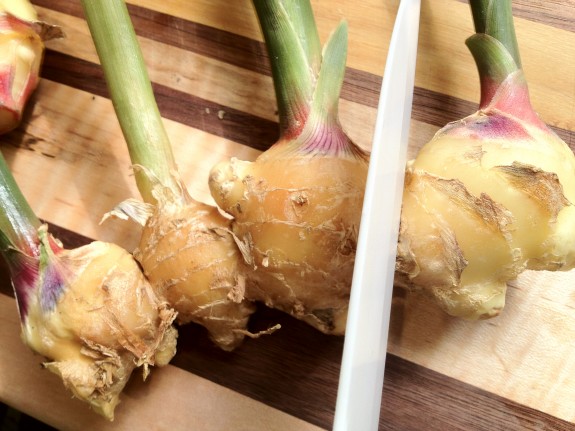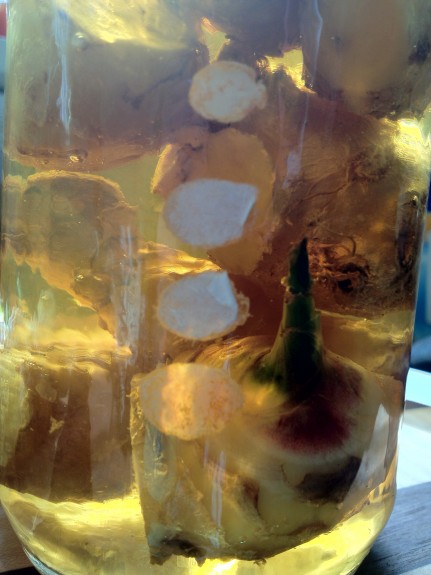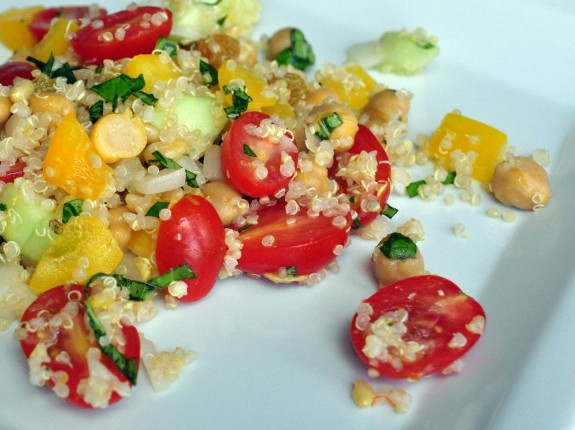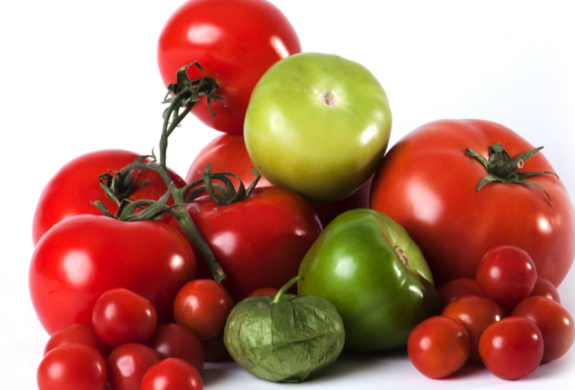Katherine’s Market Recipe: Salad of New Potatoes & Asparagus with Lemony-Garlic-Herb Mayonnaise Topped with Poached Salmon
- At May 27, 2013
- By Katherine
- In News, Recipes
 0
0

Salad of New Potatoes & Asparagus in a Lemony Garlic-Herb Mayonnaise topped with Poached Salmon (photo by Alison Eaves)
FREE: Download and print my entire new spring recipe chapter from my upcoming cookbook: “Diet Simple Farm-to-Table Recipes,” try a recipe, post its picture and your impressions on my Facebook page, and I’ll enter you in my contest for free Personalized Nutrition services. This wonderful recipe, along with many others, is included!
Today is the 4th “Katherine’s Market Recipe” of 2013, all of which are designed to be delicious, easy, quick, famiy-friendly, nutritious (heart-healthy & diabetes-friendly), and to highlight produce found at our local farmers markets this week. At your farmers market, you’ll find produce picked at peak ripeness, which means maximum flavor, texture, and nutrition. You’re also helping save the environment when you buy at your farmers market. Here’s how…
For my “Salad of ‘New’ Potatoes & Asparagus with Lemony-Garlic-Herb Mayonnaise,” I recommend you buy the asparagus, green onions, tomatoes and tiny potatoes at Wednesday’s Rose Park Farmers Market, Saturday’s Glover Park-Burleith Farmer’s Market, Sunday’s Dupont Circle’s Fresh Farm Market – OR on Sunday, come visit me demonstrating this incredible recipe at the new Downtown College Park Farmers Market.
Salad of “New” Potatoes and Asparagus with Lemony-Garlic-Herb Mayonnaise Topped with Poached Salmon
by Katherine Tallmadge, M.A., R.D.
This “salad”features the best of spring-time gifts: asparagus, green onions, thin-skinned tiny new potatoes and salmon. It can be served warm as a great holiday side dish, or enjoyed cold. The mayonnaise dressing brings out the flavor of any vegetable, especially if allowed to soak into still-warm, just cooked asparagus, haricots verts (the tender French green bean), delicate, small, thin-skinned “new” potatoes, or broccoli. The salmon can be poached, grilled, smoked or cured: your choice!
Serves 6 to 8
Mayonnaise Dressing:
1/4 Cup Mayonnaise, preferably made with Canola or Olive Oil
Grated Zest and Juice of 1 Lemon
2 Garlic cloves (or more, to taste), mashed
1 Tbsp (or more, to taste) Tarragon or other fresh herb such as Dill
Salt and Pepper, if desired (none needed)
Vegetables:
1 quart Asparagus, tough end removed, and cut into 2-inch pieces
1 pint small New Potatoes with skin, cleaned but not peeled (optional)
2 Red Bell Peppers, roasted (if desired) and chopped
1 pint cherry tomatoes, sliced in half
1 Bunch (about 4 – 5) Green Onions, chopped
Salmon:
2 pounds of salmon fillet
1 Bunch Fresh Dill
1 teaspoon Salt
Place the salmon in a frying pan large enough to hold it laid out flat. Pour cold water over salmon until it is covered. Add salt and dill to the pan. Place lid on the pan. Bring to a boil, then turn off the heat and let sit about ten minutes in the hot water. Remove the fish from the water when the flesh is opaque when checked with a fork. Let cool, if desired.
Prepare the dressing in a bowl large enough to fit the salad ingredients by mixing the mayonnaise, the lemon, garlic and fresh herb of your choice. Place in refrigerator to keep chilled.
In a frying pan large enough to fit the asparagus end to end, steam or boil the asparagus slightly (in a small amount of water) for about 3 minutes, until they are al dente (firm, but not hard, with resistance to the bite). Drain and immediately toss in ice water to stop the cooking process. Place in the bowl of cold mayonnaise dressing. Toss to coat with mayonnaise dressing. Put the bowl back into the refrigerator to halt the cooking process.
Slice the small potatoes in half or quarters, depending on their size. Boil the potatoes for about 5 or 10 minutes, until tender when pierced by a fork. Drain and place in the bowl with the mayonnaise and asparagus. Toss to coat with the mayonnaise dressing. Place in the refrigerator.
Roast the red bell peppers if desired, chop, and add to the mix. Chop the white part of the green onions, cut the cherry tomatoes in half, and place in bowl with the other vegetables; toss.
Serve the salad with about 4 ounces of salmon on top of each serving.
Katherine’s Market Recipe: Cauliflower “Vichyssoise”
- At October 23, 2012
- By Katherine
- In News, Recipes
 0
0
“Thank you for the best soup we’ve had in ages. I love it! And I hate cauliflower!” said my neighbor Nancy Flinn. A client’s teenaged son even asked for 2nd and 3rd helpings. That’s why this is one of my favorite soups. It’s adapted from “The French Culinary Institute’s Salute to Healthy Cooking,” an inspirational cookbook for me. A “Vichyssoise,” is normally cold, but I recommend you serve this hot. A traditional vichyssoise is made with cream, potatoes and leeks, but I think you’ll love this version even more – made with the more flavorful cauliflower, a little potato lending texture, and milk making it lusciously smooth.
Today is the 10th “Katherine’s Market Recipe,” all of which are designed to be delicious, easy, quick, family-friendly, nutritious (heart-healthy & diabetes-friendly), and to highlight produce found at our local Farmers Markets this week. At your Farmers Market, you’ll find produce picked at peak ripeness, which means maximum flavor, texture and nutrition. You’re also helping save the environment when you buy at your Farmers Market. Here’s how…
For my “Cauliflower Vichyssoise,” I recommend you buy the cauliflower, leeks, and potato at Georgetown’s Rose Park Farmers Market (there are only two market days left!) on Wednesday or Dupont Circle’s Fresh Farm Market (open year-round) on Sunday.
Cauliflower “Vichyssoise”
By Katherine Tallmadge, M.A., R.D.
Cauliflower is in the species of foods called “brassica.” The brassica family of foods has extremely high nutritional values and contain high levels of antioxidants and nutrients such as vitamin C, selenium, calcium, potassium, folic acid and choline – important for the brain, as well as soluble fiber, which reduces cholesterol and helps level blood sugar. Brassica, a huge category of foods including broccoli, cabbages, mustard seeds and greens, also contain potent anti-cancer compounds which help detoxify carcinogens in the liver before they continue to circulate in your bloodstream. These compounds also aid your immune response with anti-viral and anti-bacterial properties.
4 to 8 Servings
Ingredients
1 Tbsp Canola Oil
2 Leeks
1 Head Cauliflower
1 Medium Potato
6 Cups Chicken Stock (or vegetable stock), fat removed
1 Cup 1% Milk
Salt and Freshly Ground Pepper
8 leaves Fresh Parsley, Chopped
Slice the white part of the leeks, cut the cauliflower into florets and set aside. Heat canola oil in an iron skillet over medium heat. Add sliced leeks, stirring frequently for about ten minutes until soft. Stir in the stock, cauliflower and potato. Reduce the heat, cover and simmer for about twenty minutes or until vegetables are soft. When mixture has cooled a bit, puree with the The Cuisinart Smart Stick… No mess, no fuss! (or blender or food processor), add the milk. Serve hot in the cool weather, cold in the hot weather. Add salt and freshly ground pepper to taste. Garnish with chopped parsley.
700 calories in the entire pot of soup
Katherine’s Market Recipe: Butternut Squash Soup with Curry and Ginger
- At October 15, 2012
- By Katherine
- In News, Recipes
 0
0
“A ‘comfort soup’ with just the right spices to make it interesting; my ‘go to’ soup for the Fall!” says my neighbor, Constance Chatfield Taylor, president of Flying Colors Broadcasts. “Great to serve with h’oeuvres in simple demitasse cups or on Thanksgiving day.”
Winter squashes, particularly butternut, are far superior to the summer squashes and zucchini in taste and nutrition because of their deeper color and higher carbohydrate and nutrient content. The most potent squashes are the more deeply colored varieties, especially pumpkin and butternut. Their color is provided by one of the most powerful nutrients: beta-carotene.
Characterized by a chubby bowling pin shape, a buff/beige color on the outside and a deep orange on the inside, the butternut is an exceptional source of beta-carotene, an antioxidant which converts to vitamin A in your body. Beta-carotene is critical for your immune system, your skin, your vision, bones, reproduction, and more. Studies show that people who eat foods high in beta-carotene and people with high blood levels of beta-carotene have a lower incidence of certain cancers. But you won’t get the same results with a beta-carotene supplement. Study after study has shown disappointing results with the supplements. So, only the food will do! But that’s a good thing for us squash lovers.
Apparently, each squash is a bustling little factory of nutrients and phytochemicals, the plant compounds with potent powers of healing. When acting synergistically in a food, these nutrients provide a more powerful health punch than the individual nutrients alone. Some of the most important nutrients in squash are antioxidants, such as beta-carotene, alpha-carotene and vitamin C, which are powerful substances believed to reduce inflammation, improve immune function and help prevent heart disease and cancers, among other benefits.
But there are other good reasons to eat butternut squash.
Butternut squash is also a great source of fiber (good for your gastrointestinal system), potassium (important for your heart and lowers blood pressure), vitamin C (a great antioxidant important for your skin, bones and healing), magnesium (important for muscle function, the heart, bones, blood clotting, and improves diabetes),manganese (important for metabolism and bone formation) and calcium (important for your heart and bones). And a big plus: it’s low in calories, only 82 calories in a cup (7 ounces) of baked squash cubes.
Today is the 9th of “Katherine’s Market Recipes,” all of which are designed to be delicious, easy, quick, family-friendly, nutritious (heart-healthy & diabetes-friendly), and to highlight produce found at our local Farmers Markets this week. At your Farmers Market, you’ll find produce picked at peak ripeness, which means maximum flavor, texture and nutrition. You’re also helping save the environment when you buy at your Farmers Market. Here’s how…
I recommend you buy the butternut squash, “candy”onion, and garlic at Georgetown’s own Rose Park Farmers Market on Wednesday, the Glover Park – Burleith Farmers Market on Saturday, or Dupont Circle’s Fresh Farm Market on Sunday. Incredibly, you can even buy locally grown ginger at the Dupont Circle Farmers Market or other Fresh Farm Market locations from Next Step Produce, Tree and Leaf Farm, The Farm at Sunnyside, Radix Farm and Mountain View Farm. It’s simple to preserve this fresh, tender and exquisite ginger so you can have it all year long. Learn how with my step-by-step instructions for Preserving Ginger…
Butternut Squash Soup with Curry and Ginger
By Katherine Tallmadge, M.A., R.D.
About 6 servings
Ingredients:
1 Small Butternut Squash
4 Cups Water
2 Tbsp Canola Oil
1 Cup Chopped Sweet Onion (about 1 medium)
1 Clove Garlic, crushed (2 cloves, if you like it spicy)
1 tsp Curry Powder (2 tsp, if you like it spicy)
1 Tbsp fresh Ginger, about 2 inches, grated (2 Tbsp, if you like it spicy)
1 Cup Chicken or Vegetable Stock
Salt and Freshly Ground Pepper to taste
Optional Garnish: A few fresh Cilantro sprigs per bowl
Cut Butternut Squash in half, lengthwise. Scoop out seeds. Place squash face down in baking pan with 4 cups water. Bake at 350 for 45 minutes or until soft when pierced by a fork. (If you cannot slice a raw squash, as an alternative … Bake the squash whole, then slice it in half when relatively cool – add the water to the soup pot later…)
While the squash is baking, prepare the aromatic vegetables and spices: Place the oil in a large iron skillet or soup pot on medium-high. Add onions and garlic and fry until golden. Stir in curry powder, ginger, and a pinch of salt and simmer on low for a few minutes.
When the squash has cooled to the touch, pour all the water in which the squash was cooked into the skillet and stir to scrape up the bits of aromatic vegetables and spices. When squash has cooled, scoop out the butternut squash meat, leaving the skin, and stir into the mixture in the skillet. When room temperature or cool, puree the vegetable and spice mixture in a blender or food processor with the broth. Better yet, use my favorite immersible hand blender and puree right in the cooking pot: The Cuisinart Smart Stick… No mess, no fuss!
NOTE: Adjust seasonings by adding more salt, pepper or spices, if desired. Adjust consistency by adding more water or broth. Also, any similar winter squash will work well if Butternut is not available.
The entire pot of soup makes about 6 cups and is about 500 calories
Tabouleh with Chick Peas, Seasonal Vegetables and a Lemony Vinaigrette
- At August 08, 2012
- By Katherine
- In News, Recipes
 0
0
This recipe is always a huge hit. There are many potential variations: Try using Quinoa instead of Bulgur or Soy Beans instead of Chick Peas. Use Tarragon in place of basil. Every vegetable in the recipe – the tomatoes, cucumbers, peppers, sweet onions, garlic, and basil – can be found at the local Farmers Markets at Rose Park on Wednesday or Dupont Circle on Sunday or any other Fresh Farm Market locations. The possibilities are endless! This is a naturally vegan recipe. But for the meat lovers, it’s great with grilled chicken or seafood on the side.
Today is the second of “Katherine’s Weekly Market Recipes,” all of which are designed to be delicious, easy, quick, family-friendly, nutritious (heart-healthy & diabetes-friendly), and to highlight produce found at our local Farmers Markets this week. At your Farmers Market, you’ll find produce picked at peak ripeness, which means maximum flavor, texture and nutrition. You’re also helping save the environment when you buy at your Farmers Market. Here’s how…
By Katherine Tallmadge, M.A., R.D.N., L.D.
Katherine’s Weekly Market Recipe: Greek Salad with Heirloom Tomatoes
- At July 27, 2012
- By Katherine
- In News, Recipes
 0
0
When I was young, one of my most vivid memories is the taste of my Grandmother’s vine-ripened tomatoes. Every year, she would grow at least 20 tomato plants — and only tomatoes — in her back yard in Columbus, Ohio. They were her favorite vegetable (though technically a fruit), and became mine too. I’ll never forget how soft, plump, sweet and deep red they were. Definitely not today’s traveling kind. They were the kind you picked and ate, still warm from the day’s sun. The kind which you can only get from your own back yard – or the Farmers Market.
Today is the first of “Katherine’s Weekly Market Recipes,” all of which are designed to be delicious, easy, quick, family-friendly, nutritious (heart-healthy & diabetes-friendly), and to highlight produce found at our local Farmers Markets this week. At your Farmers Market, you’ll find produce picked at peak ripeness, which means maximum flavor, texture and nutrition. You’re also helping save the environment when you buy at your Farmers Market. Here’s how…
Greek Salad with Heirloom Tomatoes
By Katherine Tallmadge, M.A., R.D.
8 servings
Ingredients:
Vinaigrette:
2 Tablespoons Freshly Harvested Extra Virgin Olive Oil
2 Tablespoons Freshly Squeezed Lemon Juice (1 Lemon)
1 Tablespoon Chopped Fresh Oregano or Basil (or 1 tsp dried)
1 Clove Garlic, Minced (optional)
Salt and Pepper to Taste (Salt is not necessary with the cheese and olives)
Vegetables:
2 cucumbers, peeled, seeded and sliced into a half-moon shape
1 onion, peeled and chopped coarsely
1 medium yellow, purple or green bell pepper, cored, seeded, chopped into large bite-size pieces
1 cup pitted Kalamata or other Greek Olives
4 Heirloom Tomatoes, quartered, and cut into large, bite-size pieces
4 ounces Feta or Goat Cheese, broken into small bits
Instructions:
Combine the vinaigrette ingredients in a large salad bowl and whisk until blended. Add the cucumbers, onion, pepper, and olives and toss into vinaigrette. Let sit for twenty minutes to marinate. Add the heirloom tomatoes and cheese when ready to serve.
Tomatoes
Tomatoes are one of the “superfoods.” Men who consumed 10 or more servings of tomato products a week had a 35% decrease in risk of prostate cancer relative to those who consumed 1.5 servings or fewer per week. This is largely attributed to “lycopene” in the tomatoes, which is also in other red fruits such as watermelon, pink grapefruit and guava. Men with lycopene levels in the top 20% had a 46% decrease in risk of heart attack compared to those in the bottom 20%. Lycopene is a potent scavenger of gene-damaging free radicals. But don’t expect to get it from a supplement. You must eat the tomato as you need the whole food to receive the benefits! Here’s why…
If you would like to have one of your recipes highlighted by Katherine, please email Katherine with your recipe for testing, along with the story behind your recipe. All recipes must be heart-healthy and diabetes-friendly.


